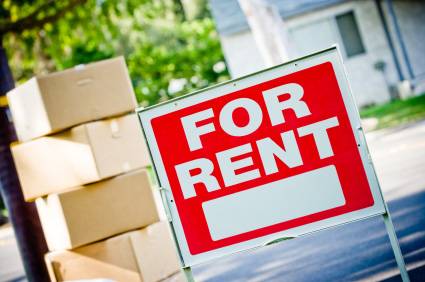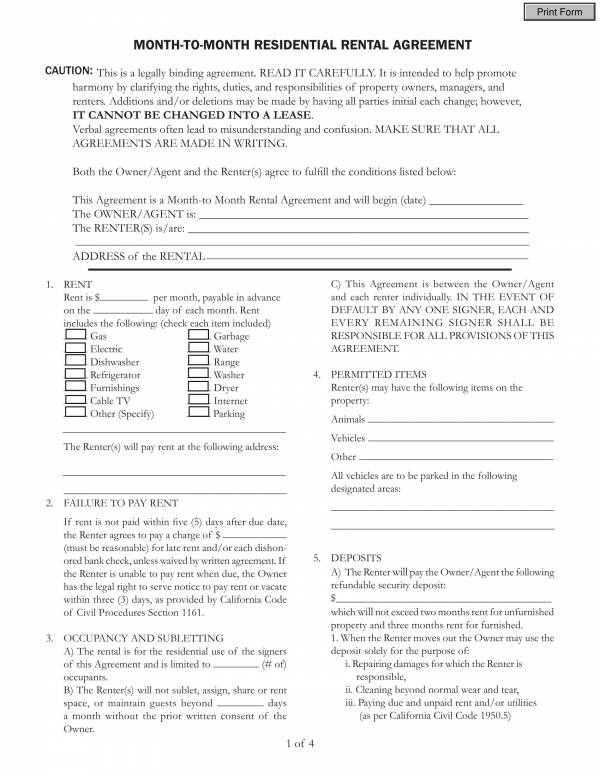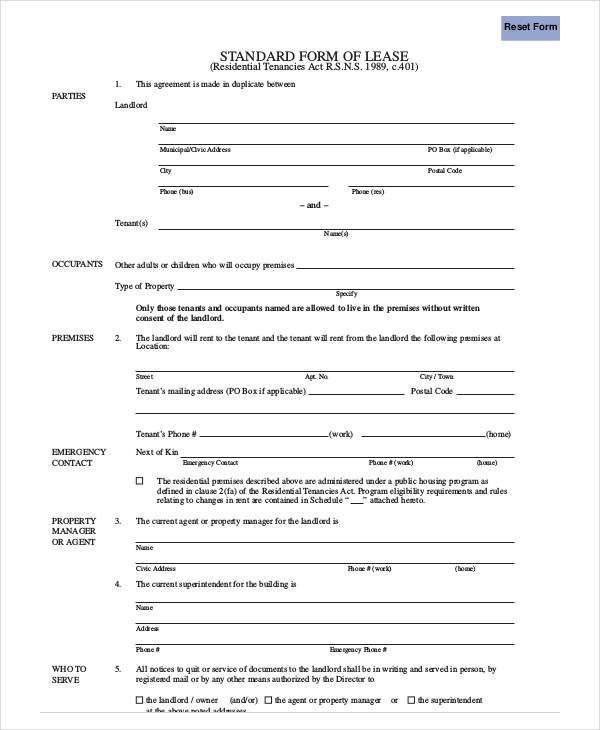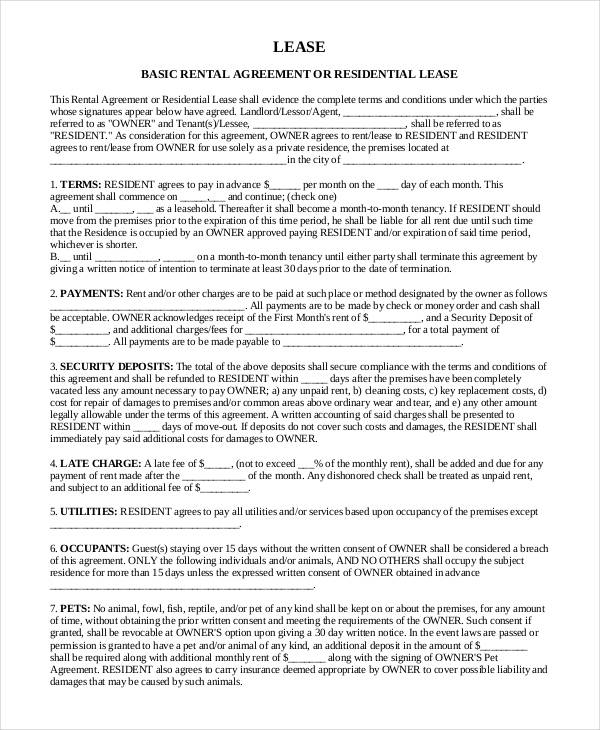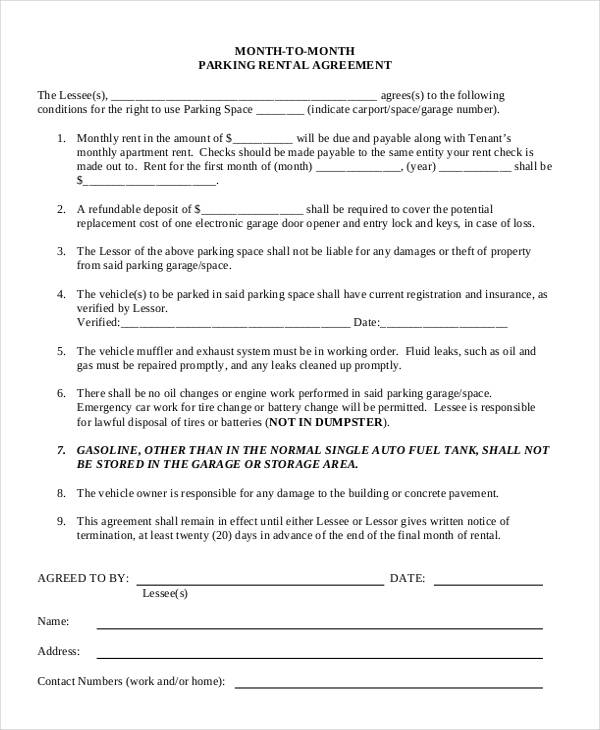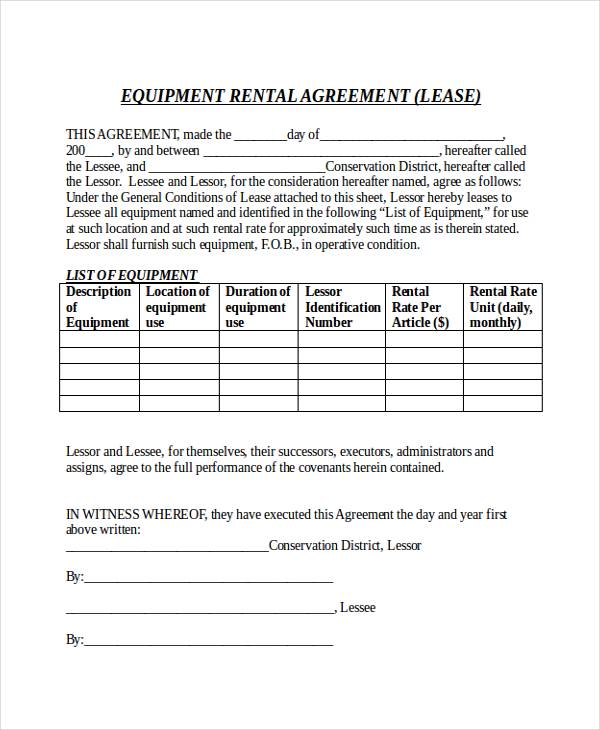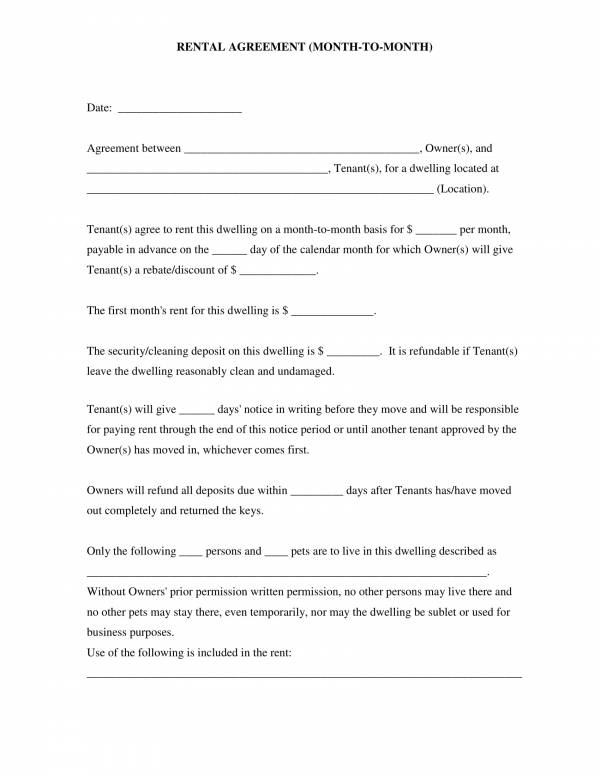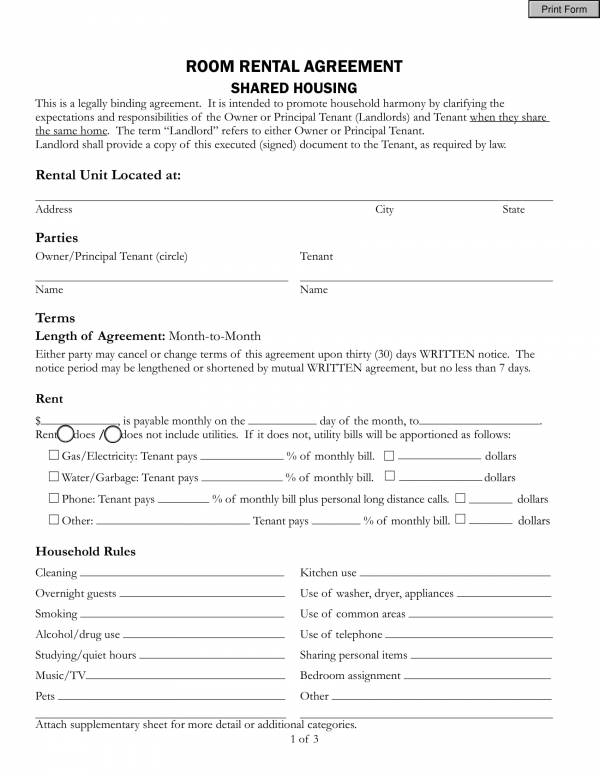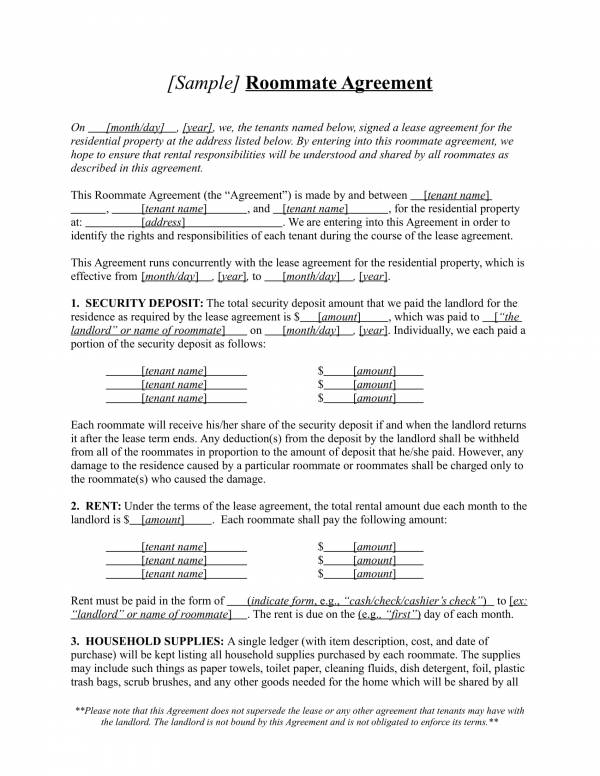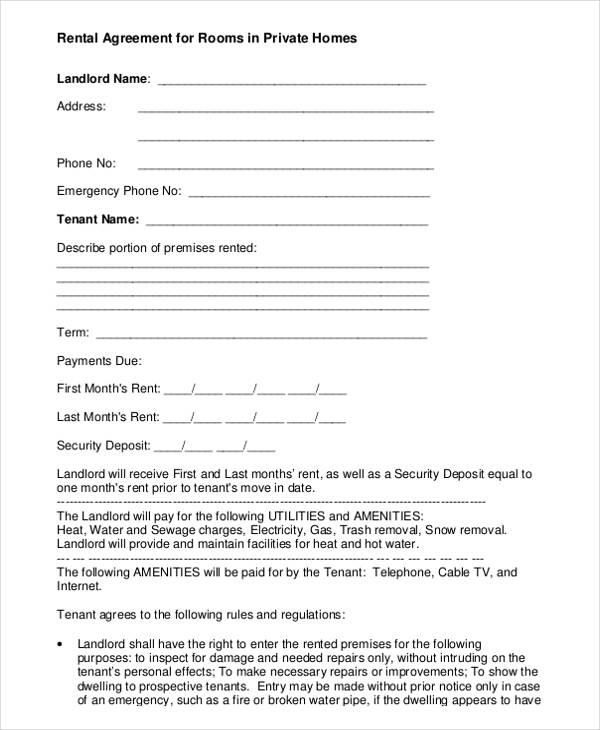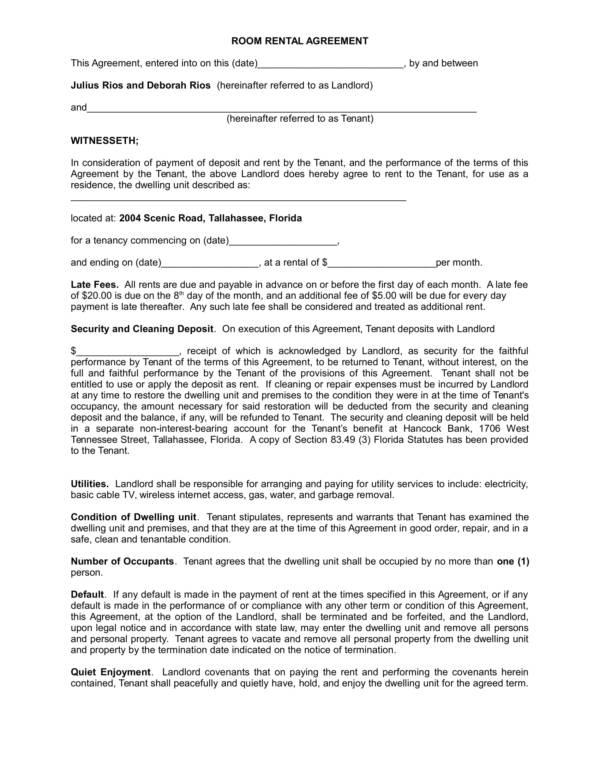A month to month rental agreement is a type of rental agreement that offers some flexibility in renting an apartment or room without having to commit to a 12 to 18 month lease. This is indeed a convenient option for individuals who are employed in temporary jobs or those who need to move constantly for some reason.
With a month to month rental agreement in place, you don’t have to worry about terminating the agreement early as you can simply send your landlord a notification for termination of your rental agreement 30 days prior to moving out. We will further discuss about month to month rental agreements in this article. For your reference, we have also included rental agreement templates that you may download.
Month to Month Residential Rental Agreement Template
Standard Month-To-Month Lease Form
Month-To-Month Room Rental Agreement Form
Month to Month Parking Rental Agreement
Equipment Month to Month Rental Agreement
Month-to-Month Rental Agreement
Room Rental Agreement for Shared Room
How Does a Month-To-Month Rental Agreement Work?
Agreements are defined as a transaction between two parties who are in agreement about something. When you say rent that means a short term use of a property or asset in exchange of the appropriate payment. So month-to-month rental agreement is an arrangement where two parties agreed to the same terms and conditions about the month-to-month use of a certain property or asset in exchange for the agreed upon payment amount.
What’s so good about a month-to month rental agreement? Unlike other forms of rental agreement, a month-to-month rental agreement offers maximum flexibility for both the renter and the owner. This is because they are not tied to long term arrangements which is typically 12 to 18 months and may hinder them from increasing the rental rates, as with the owner’ case or may give them problems with moving out or changing decisions.
It is also unlikely for a renter to get penalties in the agreement because the rental contract is due to change every month or in just four weeks. For a lot of individuals, especially for those who are always on the move, either for work or for personal things, month-to-month rental agreements always work to their advantage because they can freely move out of the rental property they occupy without having to worry about early termination.
You may also check out other related titles, like Sample Lease Rental Agreements, Sample Free Printable Rental Agreements, and Sample Blank Rental Agreements.
What Does a Month-To-Month Rental Agreement Include?
A lot of things are included in an agreement o ensure that all the related and necessary topics for discussion are covered. But you do not need to memorize or know all of these components or parts as they may vary depending on the type of agreement and its purpose. Familiarizing them and knowing about the common parts will be the better thing to do. We have here a list of the things that are commonly included in a rental agreement.
- The whole duration of the rental agreement, which is the specific start date and end date.
- Renewal terms if the rental agreement will automatically renew or not and the number of days notice needed to notify both parties about the renewal.
- The payment terms and conditions, including payment method, payment frequency, late fees, additional charges, security deposit, etc.
- The price of the rent per month.
- The names of both parties, which includes the landlord’s name and all of the tenants who will be occupying or using the rental property.
- Details about how the security deposit will be charged and used.
- Details about late fee and how it can be acquired.
- Policies about receiving guests, having sleepovers and having pets in the rental property.
- Privileges that tenants are entitled to, like parking, using of gym facilities, pool facilities, playground area, etc.
- Important and related rental agreement clauses, like a clause for property damage and early termination of agreement.
Whether you are renting a property, equipment or other things, it is best that you are familiar with and know what a rental agreement includes. With this knowledge, you can easily tell the details that are important for your agreement. This will help you decide whether to push through with the rental or not. Other related topics you may be interested in are Sample Residential Rental Agreements, Sample Home Rental Agreements, and Sample Apartment Rental Agreement Templates.
What Is the Difference Between a Month-to-Month Lease and a Fixed-Term Lease?
Now that you have been asked this question, you are starting to think and debate with yourself about their differences when you clearly think that they are the same. Well, here are some details that will help you differentiate one from the other.
Month-to-Month Lease
So, what do we know about a month-to-month lease? Well, it is pretty much everything that has been discussed above. But here are some highlights or advantages of month-to-month leases:
- It allows flexibility to both landlord and tenant as it typically lasts only for 30 days.
- Landlord’s can easily raise the price of the rent every month and earn more. The landlord can also change the terms of the rent or even have the tenant evicted from the property for any reason.
- Tenant’s will not be tied to long-term rental agreements which means they can freely move out of the rented property after just four weeks without having to pay penalties for early termination.
- 30 days notice is required from both party to alter or make any changes to the agreement.
- Tenants will not lose their deposit if they decide to move out or move elsewhere.
- Since it is a month-to-month agreement, payment is made every month and may be through written or oral arrangements.
Fixed-Term Lease
A fixed-term lease is a type of rental agreement where the tenant agrees to stay and pay for the renal property within a specific period of time as stated in the written agreement. This type of agreement is recommended for those who plan to stay in the leased property for at lease a year. Here are some advantages of a fixed-term lease that you will find different from a month-to-month lease.
- Since the lease is locked in for a specific period of time that usually from 6 months to a year, the landlord will have continuous flow of income as they can guarantee that the property will be occupied and paid for for the specified duration.
- Tenants will not be evicted to the leased property before the agreement comes to an end. There will be no lease increases and changes in the terms and conditions of the agreement while it is in effect, which is a good thing for the tenant.
- If the tenant or renter breaks their lease, then they will typically lose their deposit, as well as their pre-paid rent for the final month of their lease. Renters also need to pay for the remaining months stated in the agreement, until such time that the landlord is able to find their replacement. For example, a tenant wants to move out in the fifth month of their one year agreement and the landlord was able to find a replacement after 3 months. The tenant must pay for those three months when the property was not occupied.
Which type of arrangement do you find best for you? Knowing the difference between a month-to-month lease ans a fixed lease allows you to choose the appropriate rental arrangement that fist your needs so that you won’t have to go through all those liabilities. It’s best know something than not know anything at all. Also check out articles, like Office Lease Agreement Template, Master Professional Services Agreement, and Real Estate Partnership Agreement Templates.
Pros and Cons of Month-To-Month Rental Agreements?
Everything has their own good and bad about them and month-to-month rental agreements are no exception. Why do you have to know of both the good and the bad? It is because it keeps you are aware of them and helps you make sound decisions to avoid future problems.
The Pros of Month-to-Month Rental Agreements
- Having flexible end dates – What makes this a good thing is that you can choose the dates when you want to end the agreement. There is no need for you to wait for 12 months up to 18 months as with other agreements.
- Being able to update the rent price – As a landlord , you ca increase the rental rate as appropriate every 4 weeks. This means that you can go with the changing economic needs and earn more than you use to. Property upgrades are also made possible which is a reason ton increase the rent.
- Definitely no penalties for breaking the lease – You don”t have to worry about breaking your lease and paying for any penalties. With a month-to-month rental agreement, you will only need to wait for 4 short weeks and you can move out just like that. You will also be able to keep your security deposit and advance deposit.
- End the lease at your preferred time – If you have decided to end your lease, then you can do so anytime you want.
The Cons of Month-to-Month Rental Agreements
- There is no exact end date – What makes a month-to-month rental agreement bad is that since you don’t have a specific due date to take note of, your landlord can evict you anytime for any reason. Tenants can also move out even before the landlord has found a replacement, which means no income for them.
- There will be short notice for you to find new tenants – Tenants can also move out even before the landlord has found a replacement, which means no income for them. This leaves the landlord only 30 days to be able to find a replacement. Lucky for them if they do within this short period of time.
- Income is not that stable – The principle for this kind of business is simple. Occupied or rented properties allows you to earn, while vacant or unoccupied properties will mean zero earnings for you.
Also check out different related articles we offer on our website. Some examples are Executive Employment Agreement, Investment Agreements Samples & Templates, and HR Agreements Samples & Templates.
Editable Room Rental Agreement Template
Rental Agreement for Rooms in Private Homes
Monthly Room Rental Agreement Template
Tips in Writing Better Agreements
How can you make your agreement better? If you have no idea how to have that done, then check out these tips that we have prepared below.
- Use templates. Why do you need a template if your making your own agreement? You might not be aware yet but templates can offer you a lot of things. Using templates as reference allows you to create your own document that is complete and detailed. You don’t really need to follow everything in it, but you can learn a lot of things by comparing your own work to it.
- Observe proper formatting. If it is not the right format, then it may not work or it may just be faulty. The right format will make your agreement document look professional and presentable. Part of the formatting is using the right paper dimensions so you should look that up, too.
- Define technical terms. As much as possible use simple terms instead of trying to make an impression with the use of difficult terms. But of course, it is an agreement anyway and technical terms of different forms are commonplace. What you need to do is provide a page solely for the definition of terms so that those who are not familiar with it will be able to know and understand what those terms meant.
- Be clear and concise. Part of your goal for writing an agreement is to let the other party know and understand what it is all about, what your aims are and the main point of the agreement. With that being said, you need to be clear and concise with what you want to convey. Avoid using ambiguous words that may lead the reader to understand it differently and allow them to find faults and flaws in the agreement.
- Write the names of the parties involved. To ensure that all of the parties are bound to the agreement, have their names written on it. They should be their real and complete names, including their address and designation.
- Include related and important clauses. There are many different clauses that can be used in an agreement so make sure that you use only those that are useful and applicable to the agreement you are working on. Otherwise, using unrelated clauses may back fire and may do you bad more than good.
- Proofread your work. What makes a work professionally done and reliable? That is actually the absence of errors, both grammar errors and spelling errors. An erroneous work will make your agreement seem poorly done and lacking. If that is so, then your reader will think that it is not something that they can rely on which can ultimately lead the transaction into failure.
Remember these tips as they will surely be of help to you in your agreement writing task.
A lot can be done with agreement templates, especially if the right one is used for the right purpose. We hope that you are able to learn about rental agreements in this article, as well as other related topics. If you wish to learn more or get free templates, we have articles on our website that can help you. Some of the titles that you will find interesting are Exchange Agreements, Transfer Agreements, and Release Agreements.
Related Posts
Sample Commercial Property Management Agreement - 6+ ...
Sample Blanket Purchase Agreement - 9+ Examples in Word, PDF
Sample Commission Agreement - 10+ Examples in Word, PDF
14+ Profit Sharing Agreement Templates - PDF, DOC
7+ Equipment Rental Agreement Sample - Free Sample, Example ...
Sample Investment Contract Agreements - 7+ Examples in Word, PDF
Sample Lease Purchase Agreement - 9+ Examples in PDF, Word
Sample Lease Agreement - 23+ Free Documents Download in Word ...
Sample Vendor Confidentiality Agreement - 7+ Documents in PDF ...
15+ Owner Operator Lease Agreements - Word, PDF
Sample Business Associate Agreement - 6+ Free Documents ...
Sample Sales Agency Agreement Templates - 7+ Free Documents ...
Simple Rental Agreement - 17+ Examples in PDF, Word
Sample Construction Management Agreement - 8+ Examples in ...
Sample Consulting Retainer Agreements - 9+ Examples in Word, PDF
